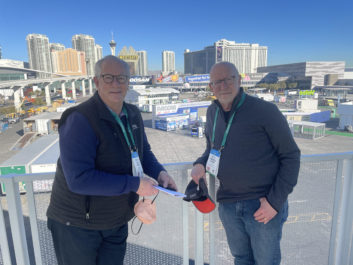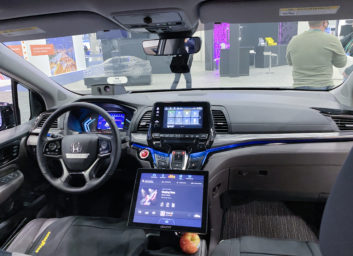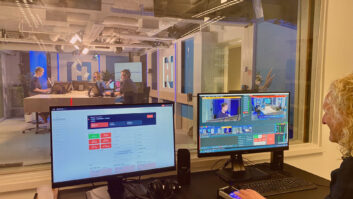Radio occupied a small albeit still relevant spot at this winter’s Consumer Electronics Show.

Jacobs Media President Fred Jacobs, who led tours of the floor for broadcasters, said the exhibition included lots of audio innovation, though it wasn’t focused on broadcast radio.
“CES has never been a place where a lot of radio-specific products are introduced. But the acceleration of technology in recent years has seemingly pushed it even further to the background,” Jacobs said.
The crowd at CES was smaller — the Consumer Technology Association estimated 40,000 — and some major exhibitors backed out because of COVID concerns. Companies nevertheless displayed and launched a myriad of consumer electronics products.
We asked Jacobs to recap his experience. (This is the second in a two-part series about the recent CES; Radio World’s Feb. 16 issue featured comments from Steve Koenig of CTA.)
Radio World: CES is when the consumer technology world debuts the latest and greatest in tech, but the impact broadcast radio makes seems negligible. Why?
Fred Jacobs: Perhaps because radio is an established thing and CES is more about technology breakouts.
There were glimpses of radio. Victrola displayed a few retro-looking radios. It was kind of lame. But what CES does offer is a chance for radio attendees to better understand the current marketplace and where technology is going. And how it affects the radio biz.
RW: You again led tours of CES with groups made up of broadcasters. What resonated for them?
Jacobs: Every year with our tours we spend a few hours running around the Las Vegas Convention Center, and at a certain point those on the tour they ask us “Hey, where is radio?” Outside of Xperi and a few odds and ends, there usually isn’t much connected with broadcast radio. But we really dig and try to connect the dots for radio execs and understand the implications of the new technology we find on radio.
For me the big thing this year, similar in scope to what we have seen in the past, was dashboard technology and the direction it is moving. Radio is not going to be Numero Uno in the dash any longer. And we are talking about vehicles made today. Radio will have to coexist with all these other media options.
Radio broadcasters came away from the tour talking about a future where radio is one of many choices in the vehicles we will drive — or that will drive us. Radio managers are realizing that if their content isn’t compelling and attention-getting, the multitude of dashboard choices will weaken radio’s position as a driving companion.
RW: Xperi again had a major presence, featuring its DTS AutoStage platform. What do you think of their efforts?

Jacobs: Xperi had a great location. All the auto stuff is in the new West Hall, and Xperi was right in the middle of that. The radio broadcasters with us enjoyed their time with Xperi, and that exhibit looked really good. Every year it seems to get bigger.
Most of the broadcasters on our tour had not experienced AutoStage. So here is this gleaming new Mercedes sedan sitting there with Xperi’s latest in-dash experience. The broadcasters asked lots of good questions about how AutoStage is going to work and how the rollout is going. I think they were just thankful and excited to see something radio at CES that looked really good.
RW: What did vehicles on display at CES look like and was radio still visible in the dash?
Jacobs: You’re seeing more dashboards that are pillar-to-pillar with one big screen. There was a Turkish car maker, called Togg, which had a screen from the driver stretching across to the front-seat passenger. It was really cool. Then there are screens in the back.
The whole idea is that everyone in the vehicle can have a different entertainment experience, which is kind of scary. But at the same time, it potentially opens up an avenue for more people to listen to the radio station of their choice while someone else is watching a movie.
An Israeli-based company, Silentium, had a display in Eureka Park [an area at CES reserved for startups and young businesses] of personal sound bubbles. Not a physical bubble, but the idea being without wearing AirPods or headphones, everyone in the car will be able to listen to whatever audio they want. It’s not physical barriers; it’s more of an acoustical or directional way of doing it by sending out inverted sound waves that cancel out noise and sound.
It hasn’t been perfected yet, but it’s a bow to the future passenger economy in cars, where companies are trying to monetize everyone in the car.
RW: CES was scaled way back due to concerns over COVID. How different was it?
Jacobs: For those who have been to CES previously it was quite different. It was still a huge exhibition. You had about half of the normal displays, but you still had a sense that you couldn’t see it all.
The first timers still had a sense of ooh and ah, but even for vets like us, what happens is you start shifting your focus away from hot new gadgets and you start recognizing technology trends and technology themes.
There were three different flying cars at CES that I noticed. That’s kind of cool. But when you explore, after a few days you see this fountain of practical technology applications of these autonomous vehicles and electrification. Those are the moments for attendees where they start connecting the dots and seeing similar trends and where radio can possibly fit in. You see where the world of technology is moving and you can’t help but go home with a different feel for what you might want to do.
Coming back from CES, the overall feel is that dashboard displays are becoming more sophisticated. AI is becoming an increasingly bigger part of the technology package and the vehicle will learn your preferences.
That can benefit or hurt radio. If you have the right content, it’s an opportunity, too. Radio has to think about competing with everybody in the car and not just other radio stations up and down the dial.
RW: The home smart speaker sector is more mature now. Any new audio components catch your eye that might stream a radio station?
Jacobs: Not really. Millions of homes in the U.S. now have smart speakers. In terms of revolutionary new technology to listen to a station’s stream or a podcast, there was nothing special. It’s all about the car, really, for radio broadcasters.
RW: You’ve written on your blog expressing a worry that U.S. radio is sitting out an audio renaissance of sorts.
Jacobs: I think radio has struggled to find its place in the audio landscape, which is ironic, and in a few different areas.
Research shows that more people are listening to audio than ever before. People’s audio pie and the numbers of listening minutes have been growing, but radio listening is not growing. The other piece is podcasting. For the publishers, podcasting has been a cash cow. But we’ve learned that most broadcasters haven’t been able to take advantage of the podcasting movement. Some broadcasters have purchased podcasting companies, but those have little to do with their broadcast holdings. So, it seems most radio stations are not participating in a meaningful way in the podcasting space.
Where radio is doing a better job is with smart speaker listening. That has been accelerated by COVID and the realization that people are not listening to more radio on traditional AM and FM radios, but they are listening more on non-traditional devices like mobile phones, tablets and smart speakers.
RW: Final thoughts on the CES experience?
Jacobs: As we visited a number of carmakers, I think broadcasters are beginning to realize this whole idea of how radio stations are displayed in the dash is going to be critical. They can’t just brush this off. And individual station owners are realizing they can effect change with their own station’s dashboard displays, whether it is RDS or HD Radio with Artist Experience.
Once you see these dashboard displays at CES, you realize that this is an area where radio has fallen behind. Yet it is within our own control to look good in these new vehicles. That’s why Steve Newberry from Quu was there and interacting with OEMs. [Quu offers software and services to add visuals to radio broadcasts.] He and his company are very eager to find out what these vehicle screens are capable of and how he can market products to help radio broadcasters maximize it to their benefit.
Randy J. Stine has spent the past 40 years working in audio production and broadcast radio news. He joined Radio World in 1997 and covers new technology and regulatory issues. He has a B.A. in journalism from Michigan State University.










